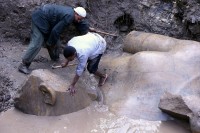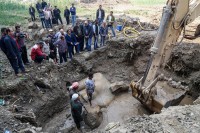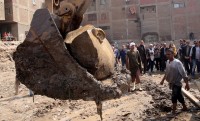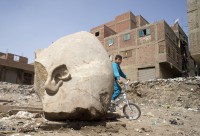 A team of Egyptian and German archaeologists have discovered the head and bust of a colossal statue, possibly of the Pharaoh Ramesses II, in a soggy pit in Matariya, a working class neighborhood of northeastern Cairo. The quartzite statue is 26 feet high. The lower part of the head, the crown, the right ear and a part of the right eye have been recovered. There is no cartouche identifying the pharaoh, nor any other inscription on the pieces of the statue that have been found, so archaeologists cannot be certain it was meant to represent Ramesses II. His temple was close to the find site, however, and he did love to make gigantic versions of himself, so he’s the leading candidate.
A team of Egyptian and German archaeologists have discovered the head and bust of a colossal statue, possibly of the Pharaoh Ramesses II, in a soggy pit in Matariya, a working class neighborhood of northeastern Cairo. The quartzite statue is 26 feet high. The lower part of the head, the crown, the right ear and a part of the right eye have been recovered. There is no cartouche identifying the pharaoh, nor any other inscription on the pieces of the statue that have been found, so archaeologists cannot be certain it was meant to represent Ramesses II. His temple was close to the find site, however, and he did love to make gigantic versions of himself, so he’s the leading candidate.
 Matariya’s mud roads and hastily erected buildings are perched above what was once the ancient city of Heliopolis. A center of religious devotion since the predynastic period, Heliopolis was deemed the home of the sun-god Atum, later Ra, and many successive pharaohs built or added onto temples there. The 18th dynasty king Thutmose III (r. 1479–1425 B.C.) built a temple that was the original home of two of the most famous obelisks in the world: the so-called Cleopatra’s Needle in Central Park, New York, and another so-called Cleopatra’s Needle in London. Tutankhamun’s father Akhenaten (r. 1353–1336 B.C.) had a temple built to his monotheistic iteration of the solar god, Aten. The solar temple built by Ramesses II (r. 1279–1213 B.C.) was so massive it was twice the size of the temple of Karnak.
Matariya’s mud roads and hastily erected buildings are perched above what was once the ancient city of Heliopolis. A center of religious devotion since the predynastic period, Heliopolis was deemed the home of the sun-god Atum, later Ra, and many successive pharaohs built or added onto temples there. The 18th dynasty king Thutmose III (r. 1479–1425 B.C.) built a temple that was the original home of two of the most famous obelisks in the world: the so-called Cleopatra’s Needle in Central Park, New York, and another so-called Cleopatra’s Needle in London. Tutankhamun’s father Akhenaten (r. 1353–1336 B.C.) had a temple built to his monotheistic iteration of the solar god, Aten. The solar temple built by Ramesses II (r. 1279–1213 B.C.) was so massive it was twice the size of the temple of Karnak.
 The German-Egyptian team have been excavating the Matariya site since 2012. It’s a race against time to stay ahead of construction, especially since a lot of isn’t legal and thus untroubled by zoning and proper permits. The site is also contaminated with industrial waste, rubbish and ever-growing piles of improperly disposed construction rubble. The difficulty is compounded by the fact that the ancient remains of Heliopolis are below groundwater level. Moving large objects like architectural features and colossal statuary, or even life-sized statuary, for that matter, out of the water to high and dry ground is challenging, hence the use of the bulldozer to fish out the head of the colossus.
The German-Egyptian team have been excavating the Matariya site since 2012. It’s a race against time to stay ahead of construction, especially since a lot of isn’t legal and thus untroubled by zoning and proper permits. The site is also contaminated with industrial waste, rubbish and ever-growing piles of improperly disposed construction rubble. The difficulty is compounded by the fact that the ancient remains of Heliopolis are below groundwater level. Moving large objects like architectural features and colossal statuary, or even life-sized statuary, for that matter, out of the water to high and dry ground is challenging, hence the use of the bulldozer to fish out the head of the colossus.
“We used the bulldozer to lift it out. We took some precautions, although somewhat primitive, but the part that we retrieved was not harmed,” said Khaled Mohamed Abuelela, manager of antiquities at Ain Shams University.
Egyptologist Khaled Nabil Osman said the statue was an “impressive find” and the area in the working class neighborhood of Matariya in eastern Cairo is likely full of other buried antiquities.
 The top section (measuring 2’7″ long) of a life-sized limestone statue of Pharaoh Seti II, grandson of Ramesses II, was also found at the Matariya site. Archaeologists hope to find more fragments of both statues as excavations continue. Conservators will work to piece them back together. If restoration is possible and more evidence is discovered identifying the colossal statue as Ramesses II, the huge sculpture will be moved to the entrance of the new Grand Egyptian Museum which is projected to open sometime next year.
The top section (measuring 2’7″ long) of a life-sized limestone statue of Pharaoh Seti II, grandson of Ramesses II, was also found at the Matariya site. Archaeologists hope to find more fragments of both statues as excavations continue. Conservators will work to piece them back together. If restoration is possible and more evidence is discovered identifying the colossal statue as Ramesses II, the huge sculpture will be moved to the entrance of the new Grand Egyptian Museum which is projected to open sometime next year.